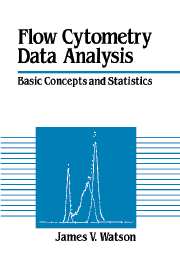Book contents
- Frontmatter
- Contents
- 1 Introduction
- 2 Fundamental concepts
- 3 Probability functions
- 4 Significance testing and fit criteria
- 5 Regression analysis
- 6 Flow cytometric sources of variation
- 7 Immunofluorescence data
- 8 DNA histogram analysis
- 9 Cell-cycle kinetics
- 10 Dynamic cellular events
- 11 Multivariate analysis primer
- 12 Epilogue
- Appendix 1: Numerical integrating routine
- Appendix 2: Normal distribution probabilities
- Appendix 3: Variance ratio tables
- Appendix 4: Mann-Whitney U tables
- Appendix 5
- Appendix 6: Regression analysis for y on x
- Appendix 7
- Appendix 8
- Appendix 9
- References
- Index
8 - DNA histogram analysis
Published online by Cambridge University Press: 27 October 2009
- Frontmatter
- Contents
- 1 Introduction
- 2 Fundamental concepts
- 3 Probability functions
- 4 Significance testing and fit criteria
- 5 Regression analysis
- 6 Flow cytometric sources of variation
- 7 Immunofluorescence data
- 8 DNA histogram analysis
- 9 Cell-cycle kinetics
- 10 Dynamic cellular events
- 11 Multivariate analysis primer
- 12 Epilogue
- Appendix 1: Numerical integrating routine
- Appendix 2: Normal distribution probabilities
- Appendix 3: Variance ratio tables
- Appendix 4: Mann-Whitney U tables
- Appendix 5
- Appendix 6: Regression analysis for y on x
- Appendix 7
- Appendix 8
- Appendix 9
- References
- Index
Summary
The cell cycle
In 1951 Howard and Pelc discovered that the DNA synthesis period occupied a discrete interval separated temporally from mitosis. The immediate conclusion was that there must be at least four distinct phases within the division cycle, one of which (mitosis) had already been defined. They termed the post-mitotic pre-synthetic phase G1 and the post-synthetic pre-mitotic phase G2. The G designation stands for “gap”, and a representation of this concept of the cell cycle, which stands to this day, is shown in Figure 8.1. In 1959 Quastler and Sherman introduced the percent labelled mitosis (PLM) curve from which the durations of the intermitotic phase times could be deduced. In this technique cells are exposed to a pulse of tritiated thymidine, a radiolabelled precursor of thymine, which is incorporated into DNA only during the DNA synthesis period. At regular intervals thereafter autoradiographs are prepared, and the percentage of mitotic figures in the population which are labelled with silver grains is scored. These percentages are plotted against the time between labelling and sampling, which gives a damped sigmoidal curve whose periodicity is that of the cell cycle. Computer model analysis of the PLM curve gives an estimate of the intermitotic phase times with their variances.
Almost as soon as the technique became available it was apparent that the cell-cycle time was invariably less than that of the doubling time of tumours growing in vivo.
Information
- Type
- Chapter
- Information
- Flow Cytometry Data AnalysisBasic Concepts and Statistics, pp. 126 - 144Publisher: Cambridge University PressPrint publication year: 1992
